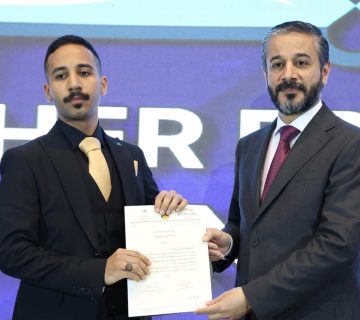The College of Engineering at University of Baghdad held a public debate of the MSc student (Saad Hazim Imran) in the Department of Petroleum Engineering about her thesis titled (Numerical Simulation of Gas Lift Optimization Using Genetic Algorithm in Iraqi Oil Field) on Wednesday (10th of March, 2024) in the Graduate Studies Hall of the Department of Petroleum Engineering.
The examining committee consisted of the following:
1- Prof. Dr. Mohammed Saleh Al-Jawad (Chairman)
2- Dr. Ali Khayoon Khalaf (Member)
3- Assist. Prof. Dr. Farqad Ali Hadi (Member)
4- Assist. Prof. Dr. Omar Falih Hasan (Member and Supervisor)
The thesis is summarized as follows:
The mature fields require to apply artificial lift techniques to sustain the economic production since the average reservoir pressure drops with the production time. Also, the giant field with high number of well requires applying the optimization techniques to manage the application of artificial lift techniques to reach the optimum production rate that corresponding to the maximum economic benefit.
In terms of the selection of optimization technique, the main function of optimization technique in gas lift is optimizing allocating gas lift injection rates for the wells in Zubair oil field. The main challenge of this task is the number of wells and the constraints, so the need for the role of artificial intelligence as optimization technique emerges more than the traditional optimization methods.
In this study, Genetic Algorithm (GA) as a powerful optimization tool is selected to optimize the gas lift application in Zubair oil field. Full production models were achieved to compute the oil production with/without gas lift application, as well as to perform many sensitivity analyses versus different cases of water cuts and average reservoir pressure.
After finishing the well algorithm with the gas lift layout, networks model, vertical lifting efficiency, PVT correlations, and merging well-producing data, the optimal gas lifting rate distributed among every well for the limited natural gas injecting rate is determined by performing a GA gas lift optimize. Key findings show that, with a limited natural gas injection rate of about 11.9 MMscf/day, it is possible to increase oil field produced from 15,766 STB/day to almost 19,846 STB/day by implementing the continuous gas lifting optimization utilizing GA technique. However, putting such techniques into practice will be expensive and require in-depth research to ensure their viability in the future. In order to confirm the viability of employing the gas lift technique from both a technical and economical point of view, sensitivity analysis at various reservoir pressures and water cut values, both before and after every gas lift technique. Based on the results, field oil output at the same rate of production and wellhead (WHP) would drastically drop about 15,766 to 5,983 STB/day if the water cut rate in petroleum-producing wells raised from 10% to 50%. The production of oil rate for the field utilizing the gas lift technique will be around 8,293 STB/day if the water cut ratio increases to 50%. Additionally, the mean reservoir pressure sensitivity result demonstrated that this field might not be able to produce profitably if the average pressure drops to approximately 2500 psi in the absence of artificial means to maintain production, whereas the average pressure drops for the gas lift proved to be approximately 590 psi.
An economic evaluation is conducted to evaluate this approach since it is always required to provide an economic rationale for the feasibility of implementing the strategies in terms of net profit. From 934576 $/day (naturally producing wells) to about 1269475 $/day (gas lifted wells), the net profit would rise. gas lift technique application is therefore required for both short- and long-term solutions in this field. Furthermore, the effectiveness of the GA approach in simulating gas lift issues has been demonstrated in a system of networks with optimal outcomes has been demonstrated.








